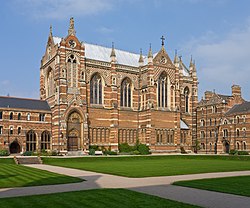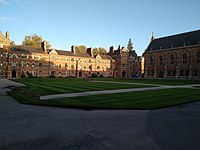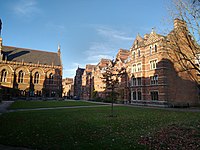Keble College, Oxford
| Keble College Latin: Collegium Keblense
| |||||||||||||||||||

| |||||||||||||||||||
|---|---|---|---|---|---|---|---|---|---|---|---|---|---|---|---|---|---|---|---|
| Warden: | Michael Jacobs | ||||||||||||||||||
| |||||||||||||||||||
| Location | |||||||||||||||||||
| Grid reference: | SP51330695 | ||||||||||||||||||
| Location: | 51°45’32"N, 1°15’28"W | ||||||||||||||||||
Keble College is one of the constituent colleges of the University of Oxford. Its main buildings are on Parks Road, opposite the University Museum and the University Parks. The college is bordered to the north by Keble Road, to the south by Museum Road, and to the west by Blackhall Road.
Keble was established in 1870, having been built as a monument to John Keble, who had been a leading member of the Oxford Movement which sought to stress the Catholic nature of the Church of England. Consequently, the college's original teaching focus was primarily theological, although the college now offers a broad range of subjects, reflecting the diversity of degrees offered across the wider university. In the period after the Second World War, the trends were towards scientific courses (proximity to the university science area east of the University Museum influenced this). As originally constituted, it was for men only and the fellows were mostly bachelors resident in the college. Like many of Oxford's men's colleges, Keble admitted its first mixed-sex cohort in 1979.[1]
The college remains distinctive for its once-controversial[2] neo-gothic red-brick buildings designed by William Butterfield. The buildings are also notable for breaking from Oxbridge tradition by arranging rooms along corridors rather than around staircases, in order that the scouts could supervise the comings and goings of visitors (Girton College, Cambridge, similarly breaks this tradition).
Keble is one of the larger colleges of the University of Oxford, with 460 undergraduates and 525 graduate students in 2021/22.[3]
Contents
History
The best-known of Keble's Victorian founders was Edward Pusey, after whom the Pusey quad and Pusey room are named.[4] The college itself is named after John Keble, one of Pusey's colleagues in the Oxford Movement, who died four years before the college's foundation in 1870. It was decided immediately after Keble's funeral that his memorial would be a new Oxford college bearing his name. The chosen architect was William Butterfield. Two years later, in 1868, the foundation stone was laid by the Archbishop of Canterbury on St Mark's Day (25 April, John Keble's birthday).[5] The college first opened in 1870, taking in thirty students, whilst the chapel was opened on St Mark's Day 1876. Accordingly, the college continues to celebrate St Mark's Day each year.
Butterfield produced a notable example of Victorian Gothic architecture, among his few secular buildings, which Pevsner characterised as "actively ugly",[6] and which, according to Charles Eastlake, defied criticism.[7] The social historian G. M. Trevelyan expressed the then commonly held, and highly dismissive, view: "the monstrosities of architecture erected by order of the dons of Oxford and Cambridge colleges in the days of William Butterfield and Alfred Waterhouse give daily pain to posterity."[8] Sir Kenneth Clark recalled that during his Oxford years it was generally believed in Oxford not only that Keble College was "the ugliest building in the world" but that its architect was John Ruskin, author of The Stones of Venice.[9] The college is built of red, blue, and white bricks; the main structure is of red brick, with white and blue patterned banding. The builders were Parnell & Son of Rugby.
On its construction, Keble was not always admired within the university. Undergraduates at St John's College started the Destroy Keble Society, which aimed to dismantle the college brick by brick.[10]
Keble is mentioned in John Betjeman's poem "Myfanwy at Oxford", as well as in the writings of John Ruskin and in Monty Python's "Travel Agent" sketch. Horace Rumpole, the barrister in John Mortimer's books, was a Law graduate of Keble.[11]
Buildings
The main site of Keble contains five quads: Liddon (the largest, named after Henry Parry Liddon), Pusey (named after Edward Bouverie Pusey), Hayward (named after Charles Hayward), De Breyne (named after Andre de Breyne) and Newman (named after John Henry Newman).[4]
Original buildings
The best-known portion of Keble's buildings is the distinctive main brick complex, designed by Butterfield.[12] The design remained incomplete due to shortage of funds. The Chapel and Hall were built later than the accommodation blocks to the east and west of the two original quadrangles and the warden's house at the south-east corner. The Chapel and Hall were both fully funded by William Gibbs and were also designed by Butterfield.
Modern buildings
A section west of the chapel was built in a different style in the 1950s with funds from Antonin Besse. Later still further significant additions have been added, most notably the modern, brick Hayward and de Breyne extensions by Ahrends, Burton and Koralek (ABK). The extensions were made possible by a generous response from the businessmen Charles Hayward and André de Breyne and other fund-raising efforts.[4] The ABK buildings included the college's memorable, futuristic "goldfish bowl" bar, opened on 3 May 1977 and recently refurbished and expanded. In 1995, work was completed on the ARCO building by the US-born architect Rick Mather. This was followed in 2002 by another similarly styled building also designed by Mather, the Sloane-Robinson building. Along with a number of additional student bedrooms the Sloane Robinson building also provided the college with the O'Reilly Theatre (a large multipurpose lecture theatre), a dedicated room for musical practice, a number of seminar rooms and a large open plan space which during term time is used as a café and social space for all members of the college. The original fellows' garden was lost in the programme of extension, as were a range of houses on Blackhall Road.
Outside links
| ("Wikimedia Commons" has material about Keble College, Oxford) |
References
- ↑ Keble past and present. Archer, Ian W., Cameron, Averil.. London: Third Millennium. 2008. ISBN 9781903942710. OCLC 232983257.
- ↑ In 1875, a writer in The Guardian dismissed Butterfield's Chapel as "fantastically picked out with zig-zag or checkerboard ornamentation", to which Butterfield responded stoutly in print, citing his East Anglian and Cotswold precedents: Paul Thompson, William Butterfield, 1971, noted in a review by J. Mordaunt Crook in The English Historical Review 1974.
- ↑ "Keble College". https://www.ox.ac.uk/admissions/graduate/colleges/keble-college.
- ↑ 4.0 4.1 4.2 "Tour the College". keble.ox.ac.uk. https://www.keble.ox.ac.uk/about/tour.
- ↑ Wilberforce, Samuel (1868). "The Resurrections of the Truth: A Sermon, preached in the Church of Saint Mary the Virgin, Oxford, on Saint Mark's Day, April 25, 1868, being the Day of Laying the First Stone of Keble College". http://anglicanhistory.org/england/swilberforce/resurrections1868.html.
- ↑ Sherwood & Pevsner 1996, p. 227.
- ↑ Eastlake, A History of the Gothic Revival "Chapel of Baliol College, Oxford", p 261f.
- ↑ Trevelyan 1944, p. 524.
- ↑ Clark 1962, p. 2.
- ↑ Whyte, William (14 October 2013). Eye of the Beholder. Oxford: Oxford University. https://issuu.com/oxfordalumni/docs/ot-mm-2013/33. Retrieved 28 June 2019.
- ↑ And finally.... Oxford: Keble College, Oxford. 2009. http://thebrick.keble.net/brick47/brick47.pdf. Retrieved 6 March 2022.
- ↑ Risebero, Bill (1985). Modern Architecture and Design: An Alternative History. MIT Press. pp. 94–. ISBN 978-0-262-68046-2. https://books.google.com/books?id=yJZS0YtaSCQC&pg=PA94. Retrieved 19 January 2013.
- Clark, Kenneth (1962). The Gothic Revival: An Essay in the History of Taste. London: John Murray. ISBN 978-0-7195-3102-6. https://books.google.com/books?id=-z2AnAEACAAJ.
- Nikolaus Pevsner: The Buildings of England: Oxfordshire, 1974 Penguin Books ISBN 978-0-300-09639-2
- Trevelyan, G. M. (1944). English Social History: A Survey of Six Centuries. London: Longmans. OCLC 465934298.
- Parkes, M. B., comp. (1979) The Mediæval Manuscripts of Keble College Oxford: a descriptive catalogue, with summary descriptions of the Greek and oriental manuscripts. xxi, 365 pp.; facsimiles. London: Scolar Press ISBN 0-85967-504-1
| Colleges of the University of Oxford | |
|---|---|
| Colleges:
All Souls • Balliol • Brasenose • Christ Church • Corpus Christi • Exeter • Green Templeton • Harris Manchester • Hertford • Jesus • Keble • Kellogg • Lady Margaret Hall • Linacre • Lincoln • Magdalen • Mansfield • Merton • New College • Nuffield • Oriel • Pembroke • The Queen's • Reuben • St Anne's • St Antony's • St Catherine's • St Cross • St Edmund Hall • St Hilda's • St Hugh's • St John's • St Peter's • Somerville • Trinity • University • Wadham • Wolfson • Worcester |
|
| Permanent private halls:
Blackfriars • Campion Hall • Regent's Park College • St Benet's Hall • St Stephen's House • Wycliffe Hall | |







